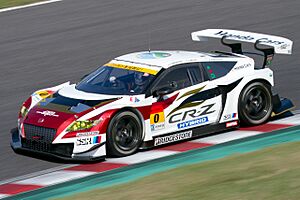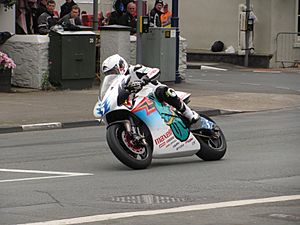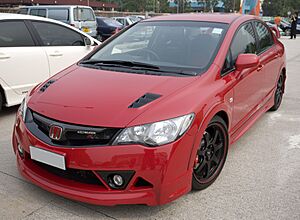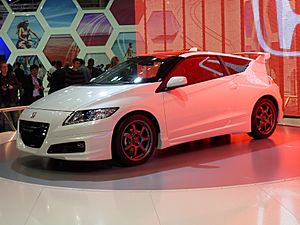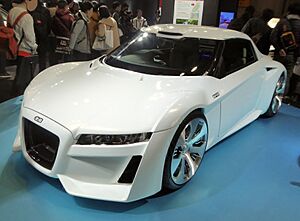Mugen Motorsports facts for kids
 |
|
|
Trade name
|
Mugen Motorsports |
|---|---|
| Private | |
| Industry | Automotive |
| Genre | Car tuning |
| Founded | 1973 |
| Founders |
|
| Headquarters | Asaka, Saitama, Japan |
M-TEC Company, Ltd., known as Mugen Motorsports (無限), is a Japanese company. It was started in 1973 by Hirotoshi Honda, who is the son of Honda Motor Company founder Soichiro Honda, and Masao Kimura. The name Mugen means "without limit" or "unlimited power."
Mugen is a special company that tunes engines and makes parts for Honda cars. They create original parts like body kits and sports exhausts. Even though Hirotoshi Honda is the founder's son, Mugen has never been owned by Honda Motor Company. However, Hirotoshi Honda became the biggest shareholder in Honda after his father passed away in 1991.
Mugen also races Honda cars in the Super GT championship. They sell special parts to car fans who want to upgrade their own vehicles. Mugen has a history of winning championships, including the Formula 3000 championship in 1990 and 1991. They were also involved in Formula One racing from 1992 to 2000. Until 2005, they were the only company supplying engines for Formula Nippon races.
Contents
Mugen's Journey: From Workshop to Racing Success
Mugen has a strong background in racing. Hirotoshi Honda started building his own race car in his father's workshop before he finished college in 1965. Masao Kimura, the co-founder, was a skilled racer with over 50 wins in Honda sports cars. He worked for Honda's research and development team before helping Hirotoshi Honda create Mugen.
In 1973, Mugen began by offering special parts for motocross bikes. As Honda made more types of vehicles, Mugen also expanded its products. The company became very good at tuning Honda engines. They started with the 1200cc Honda Civic engine and now design and build both two-stroke and four-stroke engines, making many of the main parts themselves.
Mugen always planned to build its own road cars. The first step was creating body kits for the Honda Ballade CR-X in 1984. Since then, they have made many body kits for Honda cars, including a special Mugen NSX prototype in 1992.
After some legal issues in 2003, Mugen was reorganized in 2004 and became M-TEC. The new company kept the Mugen name and its main office in Asaka, Saitama, near Tokyo. M-TEC also kept Mugen's staff and is led by Shin Nagaosa, who used to manage Mugen's NSX racing program.
Mugen's Racing Achievements
Racing in Single-Seater Cars
Mugen has grown its involvement in racing at all levels, working closely with Honda.
- Formula 3000 and Formula Nippon: In 1986, Formula 3000 racing came to Japan. Mugen and Honda teamed up to build an F3000 engine, which was used by 14 teams in 1987. The next year, Mugen cars took four of the top five spots in the Japanese F3000 championship. In 1989, Mugen won the European F3000 championship with driver Jean Alesi. Later, Mugen became the only engine supplier for the Japanese championship, which was renamed Formula Nippon.
- Formula Three: In 1988, Mugen started tuning Honda engines for Formula Three races. They won the Japanese series that year. By 1990, they expanded to Europe and won the French and British Formula Three titles. They continued to win many titles in Asia, Europe, and Latin America.
- Hillclimbing: As of 2017, Mugen Formula engines are still used and successful in European hillclimb championships. These are races where cars drive up a steep hill as fast as possible.
Mugen in Formula One Racing
| Formula One World Championship career | |
|---|---|
| First entry | 1992 South African Grand Prix |
| Last entry | 2000 Malaysian Grand Prix |
| Races entered | 147 |
| Chassis | Footwork, Lotus, Ligier, Prost, Jordan |
| Constructors' Championships | 0 |
| Drivers' Championships |
0 |
| Race victories | 4 |
| Podiums | 16 |
| Points | 182 |
| Pole positions | 1 |
| Fastest laps | 0 |
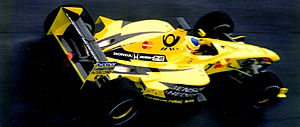
Mugen had a significant role in Formula One, the highest level of motor racing.
- Early Years (1991-1994): In 1991, Mugen prepared Honda V10 engines for the Tyrrell team. The next year, these engines were used by the Footwork team. Even after Honda left F1 in 1992, Mugen continued to work with Footwork in 1993. In 1994, Mugen partnered with Team Lotus, but the team faced financial problems and the engines couldn't show their full power.
- Ligier and First Win (1995-1996): Mugen then joined the Ligier team. In 1995, the team had a promising season, earning points in many races and achieving two podium finishes (top three). In 1996, Mugen celebrated its first ever Formula One victory with Ligier at the 1996 Monaco Grand Prix.
- Prost and Jordan (1997-2000): Ligier was taken over by Alain Prost in 1997 and became Prost Grand Prix. The Prost team also achieved podium finishes with Mugen engines. In 1998, Mugen partnered with Jordan Grand Prix. After a tough start, Jordan's luck changed at the Spa-Francorchamps race, where their drivers Damon Hill and Ralf Schumacher finished first and second, giving Jordan its first F1 win. In 1999, Jordan and Mugen had even more success, with driver Heinz-Harald Frentzen winning two races and challenging for the championship. They finished third in the Constructors' Championship, their best result ever. The year 2000 was Mugen's last in Formula One.
Sportscar Racing Success
Mugen also made a name for itself in sportscar racing, especially with the Honda NSX.
- JGTC/Super GT (1998-2002): In 1998, Mugen built four NSX models for racing. These cars were fast and started winning races, leading to a second-place championship finish for one team. In 2000, the Mugen/Dome team won the championship with driver Ryo Michigami. In 2002, Mugen-prepared NSXs won five races, and the Mugen/Dome team won the Team's championship title.
- MF408S Engine: In 2001, Mugen started developing a new 4.0-liter V8 engine called the MF408S for endurance races like the 24 Hours of Le Mans. This engine was designed to be powerful, compact, and reliable, focusing on fuel efficiency.
- GT300 and US Expansion (2004-2005): In 2004, M-TEC decided to race in the GT300 class to help train young Japanese drivers. They won the GT300 series that year, which was an unexpected bonus. M-TEC also aimed to expand into the United States, seeing races like Sebring and Daytona as great ways to promote the Mugen brand.
MF408S Engine Details
- Engine Type: 90° V8, naturally aspirated (no turbo or supercharger)
- Size: 4,000 cubic centimeters
- Max Power: Over 456 kW (612 hp) at 9,500 rpm
- Max Torque: Over 520 Nm (384 lbft) at 7,500 rpm
- Weight: 131 kg (about 289 pounds)
MF458S Engine Details
- Engine Type: 90° V8, naturally aspirated
- Size: 4,500 cubic centimeters
- Max Power: Over 600 hp (460 kW) at 8,250 rpm
- Max Torque: 587 Nm (398 lbf·ft) at 7,000 rpm
- Weight: 131 kg (about 289 pounds)
Motorcycle Racing: Isle of Man TT
Mugen has become a leading force in electric motorcycle racing at the Isle of Man TT Races. This is a famous and challenging motorcycle race held on public roads.
- Rising Speeds: Since their electric bikes, called Shinden, were introduced in 2012, their average speed around the Snaefell Mountain Course has greatly increased.
- Victories: By 2019, Mugen had won five TT Zero races (the electric bike category) with their Shinden bikes.
- Key Moments:
* 2012-2013: Mugen finished second in their first two years. * 2014: Mugen achieved its first victory with John McGuinness taking first place and teammate Bruce Anstey in second. * 2015: McGuinness and Anstey repeated their 1-2 finish. * 2016: Bruce Anstey won again for Mugen. * 2017: Anstey and Guy Martin secured another 1-2 finish for Mugen. * 2018: Michael Rutter won and set a new lap record, breaking the 120 mph barrier. * 2019: Michael Rutter won again, setting an even faster lap record, with John McGuinness completing a 1-2 finish for the team.
Mugen's Special Vehicles
M-Tec has also built special concept cars based on Honda vehicles, using their own high-performance parts. Some of these models, like the Mugen Civic RR, were even sold in Japan.
Mugen also sells individual parts for newer Honda cars, such as the 2017-2021 Civic Type-R (FK8) and the 2016-2021 Civic Hatchback (FK7). These parts include aerodynamic body kits like front lips, rear diffusers, and wings. Mugen parts are very popular for car enthusiasts in countries like the U.S. where Mugen-produced vehicles are not sold directly.
Some Mugen Vehicles and Parts
- Honda Stepwgn
- Honda City Turbo I and II
- 1984 Mugen Honda CR-X
- 1991-1996 Mugen Honda Beat
- Honda Civic SiR Mugen (various years and models)
- Honda Integra Type-R Mugen
- Mugen CRX Del Sol
- Honda Prelude
- Dc5 Honda Integra
- 2004 Honda Fit Dynamite
- 2005 Honda Legend Max
- 2006 Honda Fit Spec.D
- 2006 Honda Civic Dominator
- Mugen S2000 (2008)
- Honda Fit F154SC (2008)
- Mugen RR Experimental Spec. (Honda Civic Type R-based) (2008)
- Honda NSX Mugen RR (2009)
- Honda CR-Z: RR Concept (2012)
- Honda CBR1000RR (motorcycle)
Mugen Production Cars
- 2008 Civic Mugen Si (sold in North America)
- 2007 Civic Mugen RR (sold in Japan)
- CR-Z Mugen
- Accord Mugen
Images for kids
See also
 In Spanish: Mugen Motorsports para niños
In Spanish: Mugen Motorsports para niños
- Honda in motorsport
- Red Bull Powertrains, a company that took over Honda's F1 engines after Honda left the sport again.


